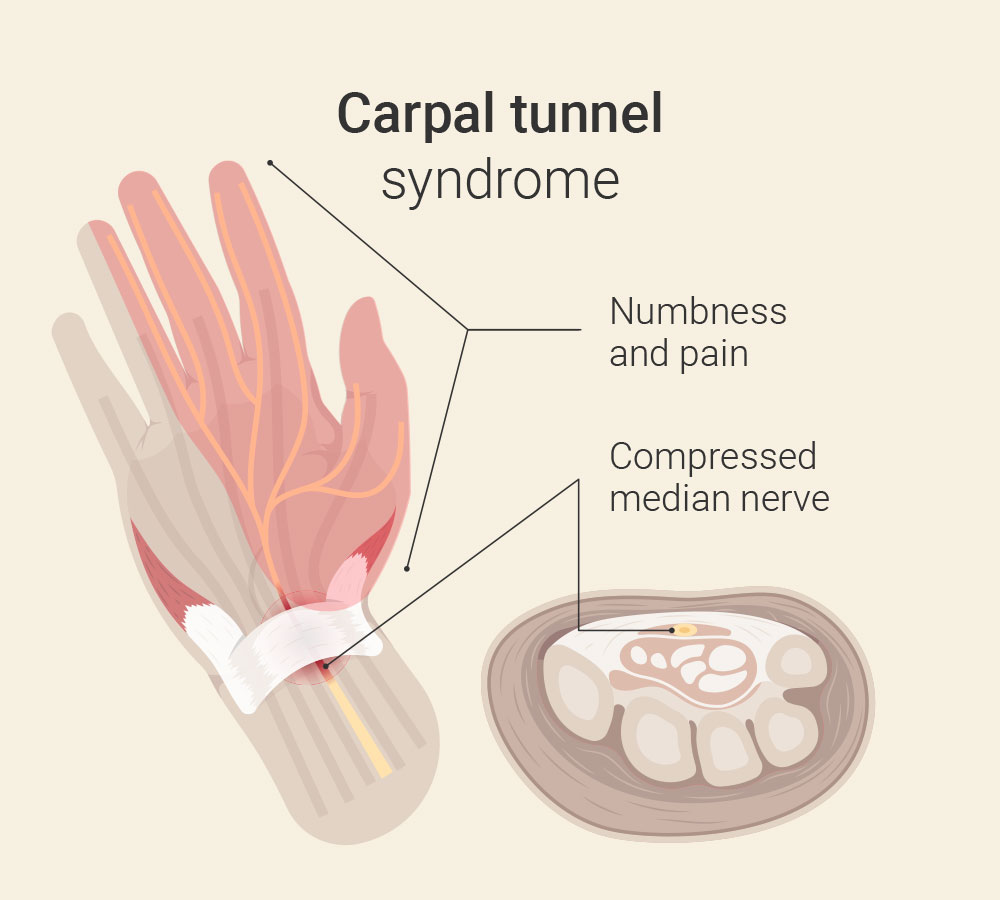Carpal tunnel syndrome is one of the most common causes of pain, numbness and weakness in the hand. The unpleasant tingling sensation is particularly noticeable at night or during certain movements and can significantly impair quality of life. But what should you do if this occurs? Early action is crucial in order to avoid permanent damage and preserve the function of the hand. Below we provide you with basic information and sensible recommendations for action.

What is carpal tunnel syndrome?
Carpal tunnel syndrome (CTS) is a common nerve compression disorder in which the so-called median nerve is constricted in the wrist area. This nerve runs through the carpal tunnel, a narrow channel bordered by carpal bones and a firm ligament (flexor retinaculum). The carpal tunnel serves as a passageway for the median nerve and tendons that are responsible for the movement of the fingers.

What symptoms are associated with CTS?
Compression of the median nerve leads to various symptoms that can increase in intensity as the disease progresses. Common symptoms are:
- Tingling and numbness
- CTS often begins with ‘formication’ in the hand, which can intensify over time.
- Tingling and numbness are usually felt in the thumb, index finger, middle finger and parts of the ring finger.
- Those affected often complain of their hand ‘falling asleep’, especially at night.
- Pain
- CTS is also usually accompanied by pulling or burning pain in the wrist, which can radiate into the fingers or arm.
- The pain is worse at night or during certain movements.
- Feeling of weakness
- Carpal tunnel syndrome also often leads to difficulties in gripping or holding objects (e.g. cup).
- Strength, especially when gripping with the thumb, may be reduced.
- Feeling of swelling
- Many sufferers have the subjective feeling that their fingers or wrist are swollen, even if no external thickening is visible.
- Fine motor impairments
-
- Due to the compressed median nerve, there are often problems with fine motor tasks, such as opening a screw cap or buttoning clothes.
- Nocturnal symptoms
- In most cases, the symptoms are particularly severe at night. Many patients wake up with pain or numbness in the hand.
- Shaking the hand often only brings temporary relief.
- Advanced signs
- Untreated carpal tunnel syndrome can lead to permanent numbness.
- In the advanced stage, the muscle in the area of the ball of the thumb (thenar muscle) can degenerate, which further restricts the mobility of the thumb.
What are the causes of CTS?
The causes of narrowing of the carpal tunnel are varied and can be favoured by various factors. Possible triggers include:
- Repetitive strain and overuse
- Monotonous movements such as typing or manual labour can permanently irritate the tendon sheaths.
- Work that repeatedly exerts pressure on the wrist (e.g. lifting heavy objects, supporting the hands) further increases the risk.
- Inflammatory processes
- Repeated inflammation of the tendon sheaths can reduce the space in the carpal tunnel.
- Joint diseases such as osteoarthritis or rheumatism often lead to swelling and inflammatory changes that can narrow the carpal tunnel.
- Hormonal changes
- Water retention and swelling in the tissue are common during pregnancy and can increase the pressure in the carpal tunnel.
- Hormonal fluctuations (e.g. during the menopause) can also lead to water retention or tissue changes.
- In addition, an underactive thyroid can favour swelling of the tissue and thus a narrowing of the tunnel.
- Mechanical causes
- Bone fractures or misalignments in the wrist can change the structure of the carpal tunnel and thus trigger CTS.
- Diseases
- High blood sugar levels due to diabetes mellitus can make the nerves more sensitive and increase the risk of developing carpal tunnel syndrome.
- Obesity can also lead to increased pressure in the carpal tunnel.
- Renal insufficiency can cause water retention and tissue swelling.
- Genetic predisposition
- A hereditary connection may also play a role, as the size and shape of the carpal tunnel vary from person to person.
What to do with carpal tunnel syndrome?
Step 1: Diagnostics
A precise diagnosis is crucial in order to clearly determine the cause of the symptoms and to differentiate between carpal tunnel syndrome and other conditions such as nerve root compression in the cervical spine. The diagnostic procedure is as follows:
Medical history
The first step is to clarify your individual symptoms and their progression. Typical questions are:
- When and how often do the symptoms occur?
- In which fingers do you feel the tingling or numbness?
- Do the symptoms get worse at night?
- Are there any activities that trigger or intensify the symptoms?
We will also ask you about risk factors such as diabetes, rheumatic diseases or occupational stress.
Physical examination
In the next step, we check the function of your hand by carrying out various tests:
- Tinel test
Light tapping on the carpal tunnel can cause tingling or pain. - Phalen test
When the wrist is flexed for about a minute, typical symptoms such as formication or numbness often occur. - Ball of thumb examination
We also check whether there is weakness or atrophy of the muscles in the thumb area.
Electrophysiological examinations
Measurements of nerve conduction can be carried out for further clarification:
- Electroneurography (ENG)
This tests the conduction velocity of the median nerve. A slowdown indicates damage or compression. - Electromyography (EMG)
This examination determines the activity of the muscles and shows whether there is already muscle damage due to the impaired nerve.
Imaging procedures
In some cases, additional imaging diagnostics may be necessary. These include, for example
- Ultrasound
Sonography shows a possible thickening of the median nerve or changes in the carpal tunnel. - MRI
Particularly in unclear cases, magnetic resonance imaging provides detailed images of your wrist and the surrounding structures.
What to do with carpal tunnel syndrome?
Step 2: Treatment
The treatment for carpal tunnel syndrome depends on the severity of the condition and your individual symptoms. The aim is to reduce the pressure on the median nerve, alleviate pain and restore the functionality of the hand. There are conservative and surgical treatment options:
Conservative treatment
These approaches are used particularly in the early stages of CTS or for mild symptoms:
- Immobilisation of the wrist
Wearing a wrist splint (especially at night) prevents the wrist from bending and relieves pressure on the median nerve. - Medication
Anti-inflammatory medication can reduce swelling and relieve pain.
In cases of severe inflammation, we can administer a cortisone injection directly into the carpal tunnel. - Physiotherapy and occupational therapy
Special exercises to stretch and strengthen the hand and forearm muscles promote mobility and blood circulation.
Occupational therapy helps to prevent incorrect posture and relieve the hand in everyday life. - Lifestyle changes
It is also advisable to reduce stressful activities – such as repetitive movements at work.
Surgical treatment
If conservative measures do not bring sufficient improvement or the symptoms are already advanced, surgical intervention may be advisable.
- Aim of the operation
The aim of surgery for CTS is to relieve the pressure on the median nerve. To do this, we cut the carpal ligament, which creates more space in the carpal tunnel. - Procedure of the operation
We make a tiny incision in the area of your wrist to expose the carpal ligament and cut it with fine instruments. Cutting the ligament usually has no negative effects on hand function. Your body adapts after the procedure and the resulting scar tissue provides sufficient stabilisation. In rare cases, minimal loss of strength may occur. However, these can usually be compensated for with targeted physiotherapy. - After the procedure
We recommend starting light movement exercises at an early stage to promote mobility. Complete healing usually takes a few weeks to months, depending on the severity and individual regeneration.
What to do with carpal tunnel syndrome? Have yourself examined by hand surgeon Dr Isabella Gruber in Frankfurt
When it comes to treating complaints such as carpal tunnel syndrome, Dr. Isabella Gruber from our private practice for orthopaedics and traumatology in Frankfurt is your ideal contact. With her expertise in hand surgery and her focus on gentle and sustainable treatment methods, she offers you comprehensive care – from the initial diagnosis to aftercare.
Dr Gruber combines the highest level of medical expertise with a sensitive and individual approach that is tailored to your personal needs. Whether conservative treatment approaches or surgical interventions – you are in good hands with Dr Gruber. Our practice is also characterised by state-of-the-art equipment and a well-coordinated team that is at your side at every stage of treatment. Make your appointment now!
1104158908 © dragonstock | 960557264 © Pepermpron | stock.adobe.com